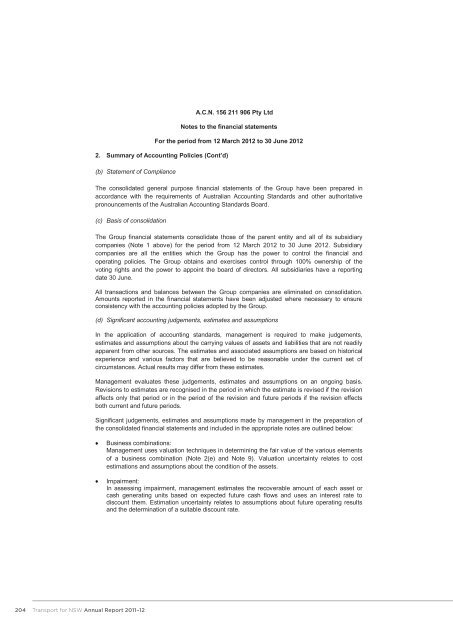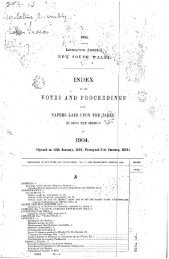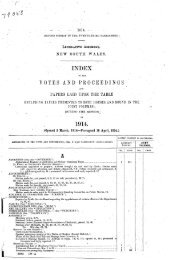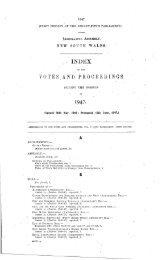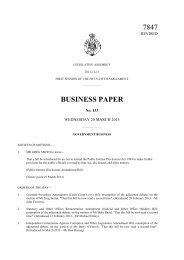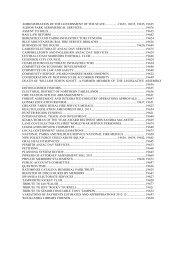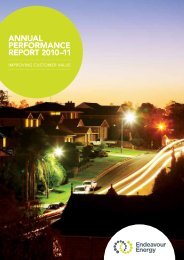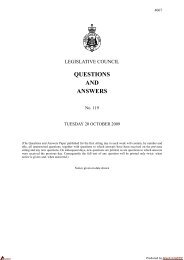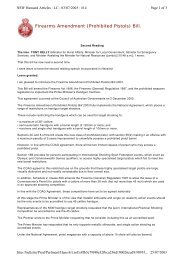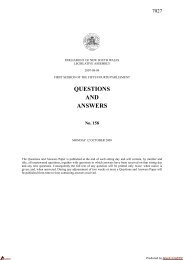- Page 1 and 2:
ANNUAL REPORT 2011-12
- Page 3 and 4:
Contents Overview 2 Director Genera
- Page 5 and 6:
Overview We place the customer at t
- Page 7 and 8:
NSW 2021 NSW 2021 is the NSW Govern
- Page 9 and 10:
Interim Corporate Plan Overview Tra
- Page 11 and 12:
Corporate Framework The Results in
- Page 13 and 14:
Job Descriptions Director General
- Page 15 and 16:
How Transport has changed It has be
- Page 17 and 18:
Operational performance Operational
- Page 19 and 20:
Operational performance Operational
- Page 21 and 22:
The insights gained from researchin
- Page 23 and 24:
Poster image used to promote the ne
- Page 25 and 26:
Responding to customer feedback Tra
- Page 27 and 28:
Travel Waratah train fleet Sydney
- Page 29 and 30:
Central Sydney Traffic and Transpor
- Page 31 and 32:
Accessibility South West Rail Link
- Page 33 and 34:
Barangaroo Integrated Transport Pla
- Page 35 and 36:
Vehicle registration initiatives A
- Page 37 and 38:
Asset Asset enhancements TfNSW is w
- Page 39 and 40:
Operational performance Operational
- Page 41 and 42:
NSW speed zones reviewed A State-wi
- Page 43 and 44:
Figure 2 - Trends in Road Fatalitie
- Page 45 and 46:
National Rail Safety Regulator All
- Page 47 and 48:
Operational performance Operational
- Page 49 and 50:
Review of GIPA functions All NSW Go
- Page 51 and 52:
• TfNSW’s payroll system was es
- Page 53 and 54:
Financial performance summary Durin
- Page 55 and 56:
Department of Transport Financial s
- Page 57 and 58:
Financial statements Financial stat
- Page 59 and 60:
Department of Transport Statement o
- Page 61 and 62:
Department of Transport Statement o
- Page 63 and 64:
Department of Transport Service gro
- Page 65 and 66:
Department of Transport Service gro
- Page 67 and 68:
Department of Transport Summary of
- Page 69 and 70:
Department of Transport Notes to th
- Page 71 and 72:
Department of Transport Notes to th
- Page 73 and 74:
Department of Transport Notes to th
- Page 75 and 76:
Department of Transport Notes to th
- Page 77 and 78:
Department of Transport Notes to th
- Page 79 and 80:
Department of Transport Notes to th
- Page 81 and 82:
Department of Transport Notes to th
- Page 83 and 84:
Department of Transport Notes to th
- Page 85 and 86:
Department of Transport Notes to th
- Page 87 and 88:
Department of Transport Notes to th
- Page 89 and 90:
Department of Transport Notes to th
- Page 91 and 92:
Department of Transport Notes to th
- Page 93 and 94:
Department of Transport Notes to th
- Page 95 and 96:
Department of Transport Notes to th
- Page 97 and 98:
Department of Transport Notes to th
- Page 99 and 100:
Department of Transport Notes to th
- Page 101 and 102:
Department of Transport Notes to th
- Page 103 and 104:
Department of Transport Notes to th
- Page 105 and 106:
Department of Transport Notes to th
- Page 107 and 108:
Department of Transport Notes to th
- Page 109 and 110:
Department of Transport Notes to th
- Page 111 and 112:
Department of Transport Notes to th
- Page 113 and 114:
Department of Transport Notes to th
- Page 115 and 116:
Department of Transport Notes to th
- Page 117 and 118:
Department of Transport Notes to th
- Page 119 and 120:
Department of Transport Notes to th
- Page 121 and 122:
Department of Transport Notes to th
- Page 123 and 124:
Department of Transport Notes to th
- Page 125 and 126:
Department of Transport Notes to th
- Page 127 and 128:
Department of Transport Notes to th
- Page 129 and 130:
Department of Transport Notes to th
- Page 131 and 132:
Department of Transport Notes to th
- Page 133 and 134:
Financial statements Financial stat
- Page 135 and 136:
Transport for NSW Statement of comp
- Page 137 and 138:
Transport for NSW Statement of chan
- Page 139 and 140:
Transport for NSW Service group sta
- Page 141 and 142:
Transport for NSW Service group sta
- Page 143 and 144:
Transport for NSW Notes to the fina
- Page 145 and 146:
Transport for NSW Notes to the fina
- Page 147 and 148:
Transport for NSW Notes to the fina
- Page 149 and 150:
Transport for NSW Notes to the fina
- Page 151 and 152:
Transport for NSW Notes to the fina
- Page 153 and 154:
Transport for NSW Notes to the fina
- Page 155 and 156: Transport for NSW Notes to the fina
- Page 157 and 158: Transport for NSW Notes to the fina
- Page 159 and 160: Transport for NSW Notes to the fina
- Page 161 and 162: Transport for NSW Notes to the fina
- Page 163 and 164: Transport for NSW Notes to the fina
- Page 165 and 166: Transport for NSW Notes to the fina
- Page 167 and 168: Transport for NSW Notes to the fina
- Page 169 and 170: Transport for NSW Notes to the fina
- Page 171 and 172: Transport for NSW Notes to the fina
- Page 173 and 174: Transport for NSW Notes to the fina
- Page 175 and 176: Transport for NSW Notes to the fina
- Page 177 and 178: Transport for NSW Notes to the fina
- Page 179 and 180: Transport for NSW Notes to the fina
- Page 181 and 182: Transport for NSW Notes to the fina
- Page 183 and 184: Financial statements Financial stat
- Page 185 and 186: Financial statements Financial stat
- Page 187 and 188: Financial statements Financial stat
- Page 189 and 190: Financial statements Financial stat
- Page 191 and 192: Financial statements Financial stat
- Page 193 and 194: Financial statements Financial stat
- Page 195 and 196: Financial statements Financial stat
- Page 197 and 198: Financial statements Financial stat
- Page 199 and 200: A.C.N. 156 211 906 Pty Ltd Financia
- Page 201 and 202: A.C.N. 156 211 906 Pty Ltd Statemen
- Page 203 and 204: A.C.N. 156 211 906 Pty Ltd Statemen
- Page 205: 1. Corporate Information A.C.N. 156
- Page 209 and 210: A.C.N. 156 211 906 Pty Ltd Notes to
- Page 211 and 212: A.C.N. 156 211 906 Pty Ltd Notes to
- Page 213 and 214: A.C.N. 156 211 906 Pty Ltd Notes to
- Page 215 and 216: A.C.N. 156 211 906 Pty Ltd Notes to
- Page 217 and 218: A.C.N. 156 211 906 Pty Ltd Notes to
- Page 219 and 220: 9. Business combination A.C.N. 156
- Page 221 and 222: A.C.N. 156 211 906 Pty Ltd Notes to
- Page 223 and 224: A.C.N. 156 211 906 Pty Ltd Notes to
- Page 225 and 226: 21. Financial Instruments (cont’d
- Page 227 and 228: Sydney Metro Financial statements F
- Page 229 and 230: Financial statements Financial stat
- Page 231 and 232: Financial statements Financial stat
- Page 233 and 234: Financial statements Financial stat
- Page 235 and 236: Financial statements Financial stat
- Page 237 and 238: Financial statements Financial stat
- Page 239 and 240: Financial statements Financial stat
- Page 241 and 242: Financial statements Financial stat
- Page 243 and 244: Financial statements Financial stat
- Page 245 and 246: Financial statements Financial stat
- Page 247 and 248: Financial statements Financial stat
- Page 249 and 250: Financial statements Financial stat
- Page 251 and 252: Appendices Appendices Appendices 24
- Page 253 and 254: Appendix 1: Acts administered by th
- Page 255 and 256: Director General, Transport NSW v A
- Page 257 and 258:
Table B: Number of applications by
- Page 259 and 260:
Number of access applications recei
- Page 261 and 262:
Appendix 5: Management and structur
- Page 263 and 264:
• Instigated substantial progress
- Page 265 and 266:
Name: Anthony Braxton-Smith Positio
- Page 267 and 268:
Name: Arthur Diakos Position: Chief
- Page 269 and 270:
Name: John Karaboulis Position: Exe
- Page 271 and 272:
Name: Stephen Enticott Position: Ge
- Page 273 and 274:
Name: Anthony Wing Position: Genera
- Page 275 and 276:
Name: Bevan Brown Position: Technic
- Page 277 and 278:
Name: Anand Thomas Position: Projec
- Page 279 and 280:
Performance indicator 09/10 10/11 1
- Page 281 and 282:
Internal reviews During the year th
- Page 283 and 284:
Previous year’s Announced Announc
- Page 285 and 286:
Previous year’s Announced Announc
- Page 287 and 288:
Previous year’s Announced Announc
- Page 289 and 290:
Previous year’s Announced Announc
- Page 291 and 292:
Appendix 7: Response to matters rai
- Page 293 and 294:
Appendix 14: Internal audit and ris
- Page 295 and 296:
Appendix 15: Risk management and in
- Page 297 and 298:
Appendix 17: Human Resources In 201
- Page 299 and 300:
Movement in salaries, wages and all
- Page 301 and 302:
Appendix 19: Occupational Health an
- Page 303 and 304:
Outcome areas Targets Actual Perfor
- Page 305 and 306:
Transport Pathways to Good Dental H
- Page 307 and 308:
Appendix 24: Payment of accounts Pa
- Page 309 and 310:
Appendix 26: Grants to non-governme
- Page 311 and 312:
Community Transport Service Provide
- Page 313 and 314:
LGA State electorate Proponent Proj
- Page 315 and 316:
Appendix 29: Research and developme
- Page 317 and 318:
Appendix 31: Bus contract region ma
- Page 319 and 320:
Appendix 33: CountryLink network ma
- Page 321 and 322:
Index Index Index 319
- Page 323 and 324:
N S Summary review of operations 4
- Page 325 and 326:
Local and Community Transport Regio


